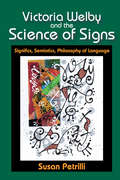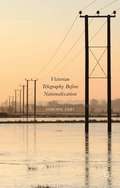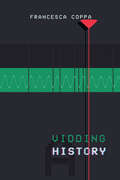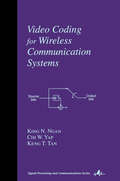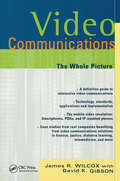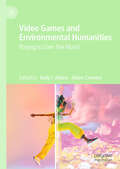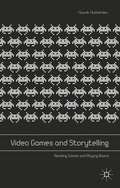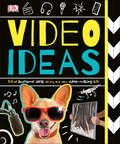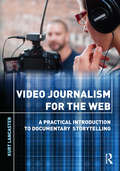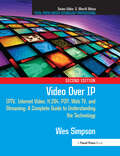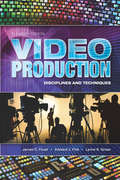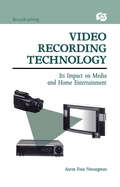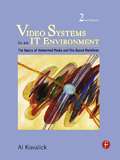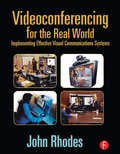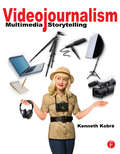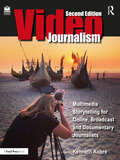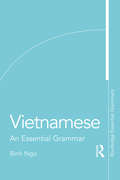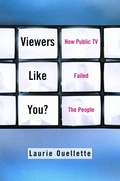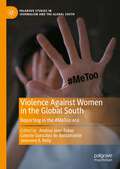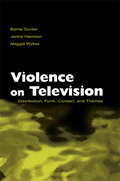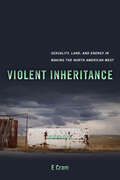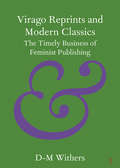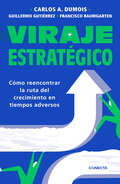- Table View
- List View
Victoria Welby and the Science of Signs: Significs, Semiotics, Philosophy of Language
by Susan PetrilliVictoria Welby (1837–1912) dedicated her research to the relationship between signs and values. She exchanged ideas with important exponents of the language and sign sciences, such as Charles S. Peirce and Charles S. Ogden. She examined themes she believed crucially important both in the use of signs and in reflection on signs. But Welby's research can also be understood in ideal dialogue with authors she could never have met in real life, such as Mikhail Bakhtin, Susanne Langer, and Genevieve Vaughan.Welby contends that signifying cannot be constrained to any one system, type of sign, language, field of discourse, or area of experience. On the contrary, it is ever more developed, enhanced, and rigorous, the more it develops across different fields, disciplines, and areas of experience. For example, to understand meaning, Welby evidences the advantage of translating it into another word even from the same language or resorting to metaphor to express what would otherwise be difficult to conceive.Welby aims for full awareness of the expressive potential of signifying resources. Her reflections make an important contribution to problems connected with communication, expression, interpretation, translation, and creativity.
Victorian Telegraphy Before Nationalization
by Simone FariVictorian Telegraphy Before Nationalization.
Vidding: A History
by Francesca CoppaVidding is a well-established remix practice where fans edit an existing film, music video, TV show, or other performance and set it to music of their choosing. Vids emerged forty years ago as a complicated technological feat involving capturing footage from TV with a VCR and syncing with music—and their makers and consumers were almost exclusively women, many of them queer women. The technological challenges of doing this kind of work in the 1970s and 1980s when vidding began gave rise to a rich culture of collective work, as well as conventions of creators who gathered to share new work and new techniques. While the rise of personal digital technology eventually democratized the tools vidders use, the collective aspect of the culture grew even stronger with the advent of YouTube, Vimeo, and other channels for sharing work. Vidding: A History emphasizes vidding as a critical, feminist form of fan practice. Working outward from interviews, VHS liner notes, convention programs, and mailing list archives, Coppa offers a rich history of vidding communities as they evolved from the 1970s through to the present. Built with the classroom in mind, the open-access electronic version of this book includes over one-hundred vids and an appendix that includes additional close readings of vids.
Video Coding for Wireless Communication Systems (Signal Processing and Communications)
by King N. Ngan Chi W. Yap Keng T. Tan"Explains the transmission of image and video information over wireless channels. Describes MPEG-4, the latest video coding standard. Discusses error resilient combined source channel image and video coders, and multiple access spread spectrum and future generation wireless video communication systems."
Video Communications: The Whole Picture
by David Gibson James WilcoxCase studies document how, in businesses all across this country, people are communicating via videoconferences with broadcast quality reception. The authors detail how the proliferation of IP networks has driven quality improvements and cost savings in
Video Games and Environmental Humanities: Playing to Save The World
by Adam Crowley Kelly I. AlianoThis edited collection investigates topics related to environmental humanities through their inclusion, exploration, or critique in contemporary video games. It focuses on how video games are a site for creating and interacting within environments, with analysis that showcases how environments are shaped within video games as well as serve as a reflection of our real world. This crossroad between the virtual and the real allows us to consider the ways in which the concepts, theories, and issues facing our real-world environment can be understood and studied through video games, particularly via the power of interactive play to teach. This book looks into how video games might empower their players to make real-world change through their immersive environments. Finally, the volume offers a consideration of ecological crises through an exploration of post-apocalyptic narratives in a wide variety of video games. This close textual analysis of video game narratives and play structures allows insight into how and why such stories were crafted and explores the various intersections between these fictional play environments and the conditions of our real world.
Video Games and Storytelling
by Souvik MukherjeeGrand Theft Auto IV saw more copies being sold than the latest superhero blockbusters or the last Harry Potter novel. Most of its players and critics commend its storytelling experience; however, when it comes to academic analysis, mainstream humanities research seems confused about what to do with such a phenomena. The problem is one of classification, in the first instance: 'is it a story, is it a game, or is it a machine?' Consequently, it also becomes a problem of methodology – which traditional discipline, if any, should lay claim to video game studies becoming the moot question. After weathering many controversies with regards to their cultural status, video games are now widely accepted as a new textual form that requires its own media-specific analysis. Despite the rapid rise in research and academic recognition, video game studies has seldom attempted to connect with older media and to locate itself within broader substantive discourses of the earlier and more established disciplines, especially those in the humanities. Video Games and Storytelling aims to readdress this gap and to bring video games to mainstream humanities research and teaching. In the process, it is also a rethinking story versus game debate as well as other key issues in game studies such as time, agency, involvement and textuality in video game-narratives.
Video Games: A Medium That Demands Our Attention (Electronic Media Research Series)
by Nicholas David BowmanThis entry in the BEA Electronic Media Research Series, born out of the April 2017 BEA Research Symposium, takes a look at video games, outlining the characteristics of them as cognitive, emotional, physical, and social demanding technologies, and introduces readers to current research on video games. The diverse array of contributors in this volume offer bleeding-edge perspectives on both current and emerging scholarship. The chapters here contain radical approaches that add to the literature on electronic media studies generally and video game studies specifically. By taking such a forward-looking approach, this volume aims to collect foundational writings for the future of gaming studies.
Video Ideas
by DKImagine and create awesome videos and animations to share with friends and family, and on YouTube, using phones, webcams, cameras, or camcorders.Inspirational and fun, this engaging book explores the video-making process from script to screen, with techniques to try out and practical tips to produce exciting projects at home. Discover how to get the best angles, lighting, and sound quality, and add special effects when recording using phone, webcam, camera, or camcorder. Turn footage into a finished product by adding visual effects with editing software, and find out how to format, upload, and create a trailer for the masterpiece. Whether you want to record special occasions, zany pets, action-packed sports events, a music video, or a stop-motion animation, Video Ideas has everything you need!The book's content supports the STEAM (Science, Technology, Engineering, Art, Math) approach to cross-curricular learning.
Video Journalism for the Web: A Practical Introduction to Documentary Storytelling
by Kurt LancasterAs newspapers and broadcast news outlets direct more resources toward online content, print reporters and photojournalists are picking up video cameras and crafting new kinds of stories with their lenses. Creating multimedia video journalism requires more than simply adapting traditional broadcast techniques: it calls for a new way of thinking about how people engage with the news and with emerging media technologies. In this guide, Kurt Lancaster teaches students and professional journalists how to shoot better video and tell better stories on the web, providing a strong understanding of cinematic storytelling and documentary production so their videos will stand out from the crowd. Video Journalism for the Web introduces students to all the basic skills and techniques of good video journalism and documentary storytelling, from shots and camera movements to sound and editing—as well as offering tips for developing compelling, character-driven narratives and using social media to launch a successful career as a "backpack journalist." Shooting, editing, and writing exercises throughout the book allow students to put these techniques into practice, and case studies and interviews with top documentary journalists provide real-world perspectives on a career in video journalism. This book gives aspiring documentary journalists the tools they need to get out in the field and start shooting unforgettable multimedia stories.
Video Over IP: IPTV, Internet Video, H.264, P2P, Web TV, and Streaming: A Complete Guide to Understanding the Technology (Fpmtp/focal Press Media Technology Professional Ser.)
by Wes SimpsonVideo Over IP gives you everything you need to know to choose from among the many ways of transferring your video over a network. The information is presented in an easy to read format, with comparison charts provided to help you understand the benefits and drawbacks of different technologies for a variety of practical applications. This new edition is expanded to fully cover HD and wireless technologies and new case studies.Whether your background is video, networking, broadcast, or telecommunications, you will benefit from the breadth of coverage that this book provides. Real-life application examples give readers successful examples of a variety of Video over IP networks that are up and running today.
Video Production: Disciplines and Techniques
by Edward J Fink James C Foust Lynne S GrossThis popular book introduces readers to the operations underlying video production. It provides thorough coverage of the theory readers need to know, balancing complexity with practical "how-to" information about detailed subjects, and it does so in a concise, conversational style. The authors have incorporated the major changes that have occurred in recent years; further increased the emphasis on digital, non-linear video production; updated and expanded information on mobile technologies; and added more than 25 new or updated figures. The subtitle remains "disciplines and techniques" because the book's focus continues to be on the fact that students need those foundations in order to be successful in video production, no matter where they may end up. Its affordable, student-friendly price, companion website, and print book and ebook options add to this book's practical nature.
Video Recording Technology: Its Impact on Media and Home Entertainment (Routledge Communication Series)
by Aaron Foisi NmungwunVideo recording has recently become an important phenomenon. Although the majority of American homes have at least one video recording set, not much is known about video recording's past and about its continual effect on affiliated industries. This text documents the history of magnetic recording, stressing its importance in consumer as well as commercial applications from the advent of magnetism through the invention of such new technologies as Digital Audio Tape (DAT), High Definition Television (HDTV), and a multitude of sophisicated Digital Video Cassette Recorders.
Video Systems in an IT Environment: The Basics of Professional Networked Media and File-based Workflows
by Al KovalickAudio/Video (AV) systems and Information Technology (IT) have collided. IT is being leveraged to create compelling networked media and file-based workflows. Video Systems in an IT Environment has helped thousands of professionals in broadcast, post and other media disciplines to understand the key aspects the AV/IT "tapeless" convergence. World-renowned educator and speaker Al Kovalick adds his conversational and witty style to this text making the book an enjoyable learning experience. Now in its second edition, this book includes: basics of networked media, storage systems for AV, MXF and other file formats, Web services and SOA, software platforms, 14 methods for high availability design, element management, security, AV technology, transition issues, real-world case studies and much more. Each chapter weaves together IT and AV techniques providing the reader with actionable information on the issues, best practices, processes and principles of seamless AV/IT systems integration.
Videoconferencing for the Real World: Implementing Effective Visual Communications Systems
by John Rhodes"John Rhodes' Videoconferencing for the Real World, is a one of the world's most comprehensive blueprints on the awesome power of videoconferencing."From the Foreword by Brad CaldwellChairman ICIA and President ofIntegrated Media Services, Anaheim, CADesigned to be useful to both technical and non-technical managers, Video-Conferencing for the Real World demystifies the subject of video communications. It provides easy-to-follow guidelines for deploying a cost-effective video-conferencing solution tailored to an organization's specific needs.Developed to flexible to the readers need, Video Conferencing for the Real World offers dynamic problem-solving techniques for the communication challenges facing managers today. Examining the technical, economic, and organizational aspects of each requirement and solution, this book offers a sound base of technical information and provides practical solutions based on a wealth of professional experience. Combining his own ideas with the input of system managers and users, service providers, consultants, and manufacturers, the author has developed a guide that will help readers make more informed investments of their time and money. Special attention is paid to conducting an effective needs analysis, and the development of solutions that will adapt easily to future changes in organizational requirements.Covering a variety of solutions, this book explores the advantages and disadvantages of desktop systems, set-top systems, rollabout systems, and room systems. In addition to compression, multipoint conferencing and data conferencing, this book also addresses topics such as, pilot projects, the preparation of RFPs, service contracts, training, content creation, and convergence.
Videojournalism: Multimedia Storytelling
by Kenneth KobreVideojournalism is a new field that has grown out of traditional print photojournalism, slideshows that combine sound and pictures, public radio, documentary filmmaking and the best of television news features. This amalgam of traditions has emerged to serve the Internet's voracious appetite for video stories.Videojournalism is written for the new generation of "backpack" journalists. The solo videojournalist must find a riveting story; gain access to charismatic characters who can tell their own tales; shoot candid clips; expertly interview the players; record clear, clean sound; write a script with pizzazz; and, finally, edit the material into a piece worthy of five minutes of a viewer's attention. Videojournalism addresses all of these challenges, and more - never losing sight of the main point: telling a great story. This book, based on extensive interviews with professionals in the field, is for anyone learning how to master the art and craft of telling real short-form stories with words, sound and pictures for the Web or television. The opening chapters cover the foundations of multimedia storytelling, and the book progresses to the techniques required to shoot professional video, and record high quality sound and market the resulting product. Videojournalism also has its own website - go to just one URL and find all the stories mentioned in the book. You also will find various "how-to" videos on the site. To keep up with the latest changes in the field such as new cameras, new books, new stories or editing software, check the site regularly and "like" www.facebook.com/KobreGuide.
Videojournalism: Multimedia Storytelling for Online, Broadcast and Documentary Journalists
by Kenneth KobreVideojournalism: Multimedia Storytelling for Online, Broadcast and Documentary Journalists is an essential guide for solo video storytellers—from "backpack" videojournalists to short-form documentary makers to do-it-all broadcast reporters.Based on interviews with award-winning professionals sharing their unique experiences and knowledge, Videojournalism covers topics such as crafting and editing eye-catching short stories, recording high-quality sound, and understanding the laws and ethics of filming in public and private places. Other topics include:• understanding the difference between a story and a report• finding a theme and telling a story in a compact time frame• learning to use different cameras and lenses—from smart phones to mirrorless and digital cinema cameras• using light, both natural and artificial • understanding color and exposureThe second edition of this best-selling text has been completely revised and updated. Heavily illustrated with more than 550 photographs, the book also includes more than 200 links to outstanding examples of short-form video stories. Anatomy of a News Story, a short documentary made for the book, follows a day in the life of a solo TV videojournalist on an assignment (with a surprise ending), and helps readers translate theory to practice.This book is for anyone learning how to master the art and craft of telling real, short-form stories with words, sound, and pictures for the Web or television.A supporting companion website links to documentaries and videos, and includes additional recommendations from the field’s most prominent educators.
Vietnamese: An Essential Grammar (Routledge Essential Grammars)
by Binh NgoVietnamese: An Essential Grammar is a concise and user-friendly reference guide to modern Vietnamese. It presents a fresh and accessible description of the language in short, readable sections. Features include: Clear and up-to-date examples of modern usage. Special attention to those points which often cause problems to English-speaking learners. Vietnamese / English comparisons and contrasts highlighted throughout. The final section covers pronunciation, providing an introduction to the syllable structure of Vietnamese, and highlighting common errors made by English-speaking learners. Accompanying audio tracks for this chapter are available at www.routledge.com/9781138210707. Vietnamese: An Essential Grammar is ideal for learners involved in independent study and for students in schools, colleges, universities and adult classes of all types.
Viewers Like You: How Public TV Failed the People
by Laurie OuelletteHow "public" is public television if only a small percentage of the American people tune in on a regular basis? When public television addresses "viewers like you," just who are you? Despite the current of frustration with commercial television that runs through American life, most TV viewers bypass the redemptive "oasis of the wasteland" represented by PBS and turn to the sitcoms, soap operas, music videos, game shows, weekly dramas, and popular news programs produced by the culture industries. Viewers Like You? traces the history of public broadcasting in the United States, questions its priorities, and argues that public TV's tendency to reject popular culture has undermined its capacity to serve the people it claims to represent. Drawing from archival research and cultural theory, the book shows that public television's perception of what the public needs is constrained by unquestioned cultural assumptions rooted in the politics of class, gender, and race.
Vinnie the Dove: Targeting the v Sound (Speech Bubbles 2)
by Melissa PalmerVinnie loves to dive in water, but it always makes him so cold! Join him on his mission to find a way to finally get warmed up. This picture book targets the /v/ sound and is part of Speech Bubbles 2, a series of picture books that target specific speech sounds within the story. The series can be used for children receiving speech therapy, for children who have a speech sound delay/disorder, or simply as an activity for children’s speech sound development and/or phonological awareness. They are ideal for use by parents, teachers or caregivers. Bright pictures and a fun story create an engaging activity perfect for sound awareness. Picture books are sold individually, or in a pack. There are currently two packs available – Speech Bubbles 1 and Speech Bubbles 2. Please see further titles in the series for stories targeting other speech sounds.
Violence Against Women in the Global South: Reporting in the #MeToo era (Palgrave Studies in Journalism and the Global South)
by Andrea Jean Baker Celeste González de Bustamante Jeannine E. RellyBringing together 14 journalism scholars from around the world, this edited collection addresses the deficit of coverage of violence against women in the Global South by examining the role of the legacy press and social media that report on and highlight ways to improve reporting. Authors investigate the ontological limitations which present structural and systemic challenges for journalists who report on the normalization of violence against women in country cases in Argentina; Brazil; Mexico; Indonesia; Kenya, Nigeria, South Africa; Egypt; Libya, Syria, and Yemen. Challenges include patriarchal forces; gender imbalance in newsrooms; propaganda and censorship strategies by repressive, hyper-masculine, and populist political regimes; economic and digital inequities; and civil and transnational wars. Presenting diverse conceptual, methodological, and empirical chapters, the collection offers a revision of existing frameworks and guidelines and aims to promote more gender-sensitive, trauma-informed, solutions-driven, and victim or survivor centered reporting in the region.
Violence on Television: Distribution, Form, Context, and Themes (Routledge Communication Series)
by Barrie Gunter Maggie Wykes Jackie HarrisonConcern about violence on television has been publicly debated for the past 50 years. TV violence has repeatedly been identified as a significant causal agent in relation to the prevalence of crime and violence in society. Critics have accused the medium of presenting excessive quantities of violence, to the point where it is virtually impossible for viewers to avoid it. This book presents the findings of the largest British study of violence on TV ever undertaken, funded by the broadcasting industry. The study was carried out at the same time as similar industry-sponsored research was being conducted in the United States, and one chapter compares findings from Britain and the U.S.A. The book concludes that it is misleading to accuse all broadcasters of presenting excessive quantities of violence in their schedules. This does not deny that problematic portrayals were found. But the most gory, horrific and graphic scenes of violence were generally contained within broadcasts available on a subscription basis or in programs shown at times when few children were expected to be watching. This factual analysis proves that broadcasters were meeting their obligations under their national regulatory codes of practice.
Violent Inheritance: Sexuality, Land, and Energy in Making the North American West (Environmental Communication, Power, and Culture #3)
by E CramViolent Inheritance deepens the analysis of settler colonialism's endurance in the North American West and how infrastructures that ground sexual modernity are both reproduced and challenged by publics who have inherited them. E Cram redefines sexual modernity through extractivism, wherein sexuality functions to extract value from life including land, air, minerals, and bodies. Analyzing struggles over memory cultures through the region's land use controversies at the turn of and well into the twentieth century, Cram unpacks the consequences of western settlement and the energy regimes that fueled it. Transfusing queer eco-criticism with archival and ethnographic research, Cram reconstructs the linkages—"land lines"—between infrastructure, violence, sexuality, and energy and shows how racialized sexual knowledges cultivated settler colonial cultures of both innervation and enervation. From the residential school system to elite health seekers desiring the "electric" climates of the Rocky Mountains to the wartime incarceration of Japanese Americans, Cram demonstrates how the environment promised to some individuals access to vital energy and to others the exhaustion of populations through state violence and racial capitalism. Grappling with these land lines, Cram insists, helps interrogate regimes of value and build otherwise unrealized connections between queer studies and the environmental and energy humanities.
Virago Reprints and Modern Classics: The Timely Business of Feminist Publishing (Elements in Publishing and Book Culture)
by D-M WithersReprinting, republishing and re-covering old books in new clothes is an established publishing practice. How are books that have fallen out of taste and favour resituated by publishers, and recognised by readers, as relevant and timely? This Element outlines three historical textures within British culture of the late 1970s and early 1980s – History, Remembrance and Heritage – that enabled Virago's reprint publishing to become a commercial and cultural success. With detailed archival case studies of the Virago Reprint Library, Testament of Youth and the Virago Modern Classics, it elaborates how reprints were profitable for the publisher and moved Virago's books - and the Virago brand name - from the periphery of culture to the centre. Throughout Virago's reprint publishing - and especially with the Modern Classics - the epistemic revelation that women writers were forgotten and could, therefore, be rediscovered, was repeated, again and again, and made culturally productive through the marketplace.
Viraje estratégico: cómo reencontrar la ruta del crecimiento en tiempos adversos
by Guillermo Gutiérrez Carlos A. Dumois Francisco BaumgartenUNA METODOLOGÍA DE CAMBIO ESTRATÉGICO PARA EMPRESAS QUE VIVEN TIEMPOS DIFÍCILES. Las empresas hoy en día se encuentran en alto riesgo: la incertidumbre económica, el desenfoque de sus negocios, la tolerancia a resultados mediocres y la falta de liderazgo las hacen más susceptibles a las crisis. En Viraje estratégico los consultores internacionales Carlos, Guillermo y Francisco comparten un método propio basado en la cultura corporativa latinoamericana y probado en cientos de empresas familiares que superaron sus dificultades y encontraron un nuevo camino de crecimiento y sostenibilidad. Al mejor estilo de experimentados navegantes, analizan las vías de rescate cuando los negocios se estancan o están cerca del naufragio. Su misión es facilitar la comprensión de esas dificultades e impulsar a los líderes empresarialesa rescatar su capacidad de creación de valor. Además, ilustran cada etapa del proceso con siete emblemáticos casos reales de viraje. Enfrenta las tormentas organizacionales y aprende a convertirlas en grandes oportunidades de cambio que no solo salven a tu empresa de la quiebra, sino que reconstruyan su viabilidad hacia el futuro.
